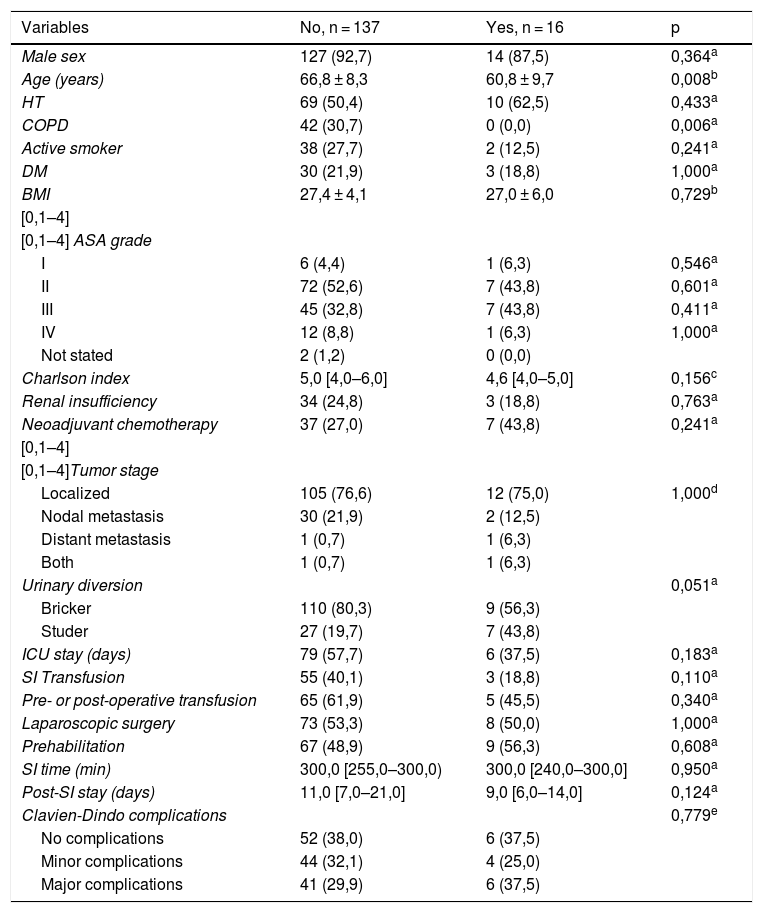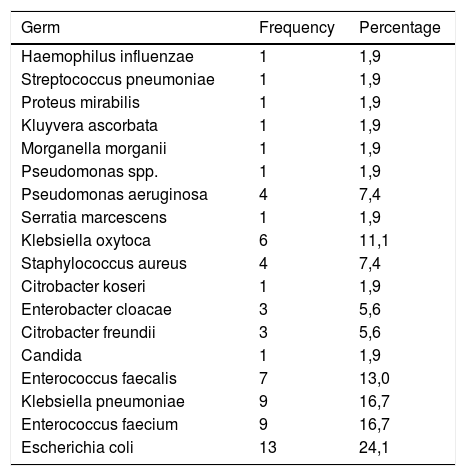Radical cystectomy with urinary diversion associated with extended pelvic lymphadenectomy continues to be the treatment of choice in muscle invasive bladder cancer. Sixty-four percent of patients submitted to this procedure present postoperative complications, with urinary infection being responsible in 20–40% of cases. The aim of this project is to assess the rate of urinary infection as a cause of re-admission after cystectomy, and to identify protective and predisposing factors for urinary infection in our environment. Finally, we will evaluate the outcomes after the establishment of a prophylactic antibiotic protocol after removal of ureteral catheters.
Material and methodsRetrospective descriptive study of cystectomized patients in the Urology Service of the Hospital Clínico Universitario of Zaragoza, from January 2012 to December 2018. A urinary tract infection (UTI) prevention protocol after catheter removal is established for all patients since October 2017.
ResultsUTI is responsible for 54.7% of readmissions, with 55.1% of these being due to UTI after removal of ureteral catheters. Of the patients who received with prophylaxis, 9.5% presented UTIs after withdrawal, compared to 10.6% in the group of patients without prophylaxis. The patient who is re-admitted for UTI after withdrawal has a mean catheter time of 24.3 ± 7.2 days, compared to 24.5 ± 7.4 days for patients in the group without UTI (P = .847).
ConclusionsThe type of urinary diversion performed is not related to the rate of urinary infection. The regression model does not identify antibiotic prophylaxis, nor catheter time, as independent factors of UTI after catheter removal.
La cistectomía radical con derivación urinaria asociada a linfadenectomía pélvica ampliada continúa siendo el tratamiento de elección en el cáncer vesical musculoinvasivo. Un 64% de los pacientes presentan complicaciones postoperatorias, siendo la infección urinaria responsable en un 20–40% de los casos. El objetivo del presente proyecto es valorar la tasa de infección urinaria como causa de reingreso tras cistectomía, e identificar factores protectores y predisponentes de infección urinaria en nuestro medio. Por último, conocer los resultados obtenidos al aplicar el protocolo de profilaxis antibiótica tras la retirada de los catéteres ureterales.
Material y métodosEstudio descriptivo retrospectivo de pacientes cistectomizados en el Servicio de Urología del Hospital Clínico Universitario desde enero de 2012 hasta diciembre de 2018. Desde octubre de 2017, de forma estandarizada, a todo paciente se le aplica un protocolo de prevención de infección del tracto urinario (ITU) tras la retirada de catéteres.
ResultadosLa ITU es responsable del 54,7% de los reingresos, siendo un 55,1% de estos por causa de una ITU tras la retirada de los catéteres ureterales. El 9,5% de los pacientes con profilaxis presenta ITU tras la retirada, frente a un 10,6% en el grupo de pacientes sin profilaxis. El paciente que reingresa por ITU tras la retirada tiene un tiempo de catéteres medio de 24,3 ± 7,2 días, frente a los 24,5 ± 7,4 días en el grupo sin ITU (p = 0,847).
ConclusionesEl tipo de derivación urinaria empleada no guarda relación con la tasa de infección urinaria. El modelo de regresión no identifica la profilaxis antibiótica, ni tampoco el tiempo de catéteres, como factores independientes de ITU tras la retirada de los catéteres.
Artículo
Comprando el artículo el PDF del mismo podrá ser descargado
Precio 19,34 €
Comprar ahora













